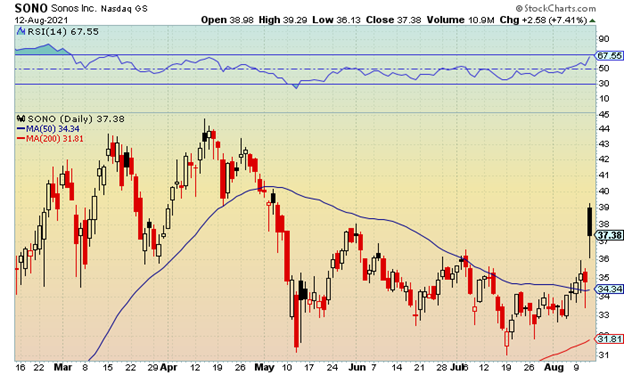Sonos (SONO) is a relatively new company that has only been trading on the major exchanges for a few years. In August 2018, the company priced its initial public offering at $15 a share, below the expected range of $17–$19.
SONO made a splashy debut on the market, zooming 32% in its first day of trading to close just below $20, giving the company an implied market value of nearly $2 billion. Nearly three years later, the market cap has more than doubled to $4.6 billion.

The company makes high-end wireless speakers that allow consumers to easily play music, audiobooks, radio, and podcasts. Although this is a very lucrative space that includes competition from Apple, Amazon, Bose, Google, and Samsung, SONO has quietly outpaced the heavy hitters and is emerging as a leading brand.
Management has done a fantastic job of integrating software with hardware to overcome the commoditization process, with SONO developing numerous patents to stay ahead of the field. Recent earnings back this up, as the company has reported another record-breaking quarter.
Third-quarter earnings came in at $0.27 per share, versus estimates for a loss of $0.17. Revenue of $379 million also outpaced forecasts of $313 million, with SONO also raising its 2021 guidance.
Fiscal year 2021 revenue was upped to $1.695–$1.71 billion from $1.625–$1.675 billion, with adjusted EBITDA (earnings before interest, taxes, depreciation, and amortization) now expected to come in at $270–$280 million, up from $225–$250 million.
Looking at the chart, we can see shares reached a 52-week—and all-time—peak of $44.72 in mid-April, before plunging to a low of $31.22 by mid-May. This level was tested again in mid-July, with SONO shares back in a solid uptrend after consolidating near $33 earlier this month. Key resistance at $39 held on the earnings beat, with continued closes above this level being a bullish signal going forward.

Given the string of earnings beats, the trend is just getting started; momentum could continue to build for the rest of 2021, with constraints easing and retail stores continuing to reopen. SONO should also benefit from a growing and more involved customer base thanks to ongoing at-home spending trends.
For aggressive traders, longer-term options are available to write as covered calls or to speculate on a run past prior highs. The SONO December 35 calls are currently trading just above the $5 level and could sold by investors long the stock to protect against a fade from current levels.
If shares do make a run towards $45 by December 17, these call options would nearly double from current levels. We would see a breakeven point if shares trade just above the $40 level by that same date. A total loss of premium would occur if shares fade from current levels and are back below $35 by mid-December.





